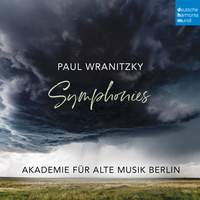Recording of the Week,
Wranitzky Symphonies from Akademie für Alte Musik Berlin
Although he appears to have been one of the brightest stars of musical Vienna at a time when the firmament also included Mozart, Beethoven and Haydn, Paul Wranitzky’s huge body of work isn’t especially well-represented on disc: the tide does seem to be turning, though, with a series of recordings from Marek Štilec on Naxos well underway, and today the Akademie für Alte Musik Berlin and their concert-master Bernhard Forck enter the fray with a superb set of three symphonies recorded in camera whilst live performances were on hiatus during last winter’s lockdown.
 Born in Moravia in 1756 (the same year as Mozart), Pavel Vranický headed to Vienna to seek his fortune aged twenty, modifying his name along the way and rapidly gaining a foothold in the city as both composer and concert-master: Beethoven and Haydn held him in high esteem, enlisting him to direct premieres of their works from the violin, and there are at least half-a-dozen passages on this album which make one wonder whether Wranitzky’s vivid musical imagination exerted a certain influence over some of their best-known compositions…
Born in Moravia in 1756 (the same year as Mozart), Pavel Vranický headed to Vienna to seek his fortune aged twenty, modifying his name along the way and rapidly gaining a foothold in the city as both composer and concert-master: Beethoven and Haydn held him in high esteem, enlisting him to direct premieres of their works from the violin, and there are at least half-a-dozen passages on this album which make one wonder whether Wranitzky’s vivid musical imagination exerted a certain influence over some of their best-known compositions…
The album opens with the overture to the fairy-tale opera Oberon, commissioned by the impresario Emanuel Schikaneder for the Theater auf der Wieden in 1789. The work seems to have put Schikaneder’s new venture firmly on Vienna’s musical map: another fantastical singspiel, Mozart’s Die Zauberflöte, received its premiere at the same venue two years later, and after Mozart’s premature death Goethe was apparently minded to approach Wranitzky with a view to collaborating on a sequel.
It makes for a lively curtain-raiser, with the Akamus strings on gutsy, resonant form in the dramatic opening flourishes, and the plangent timbre of the period woodwind-instruments making delightful work of the lilting pastoral theme. The flutes sprinkle tasteful amounts of fairy-dust, but there’s grandeur too, and just a suggestion of the thunderclouds which loom in the ‘Tempest’ Symphony which closes the disc. On the evidence here, it seems a pity that the piece was subsequently eclipsed by the success of Weber’s opera on the same theme: what a treat it would be to have a recording of the whole thing…
 We segue straight from fairy-land to the battle-field, in the form of the extraordinary ‘Grande Symphonie caractéristique pour la Paix avec la République francaise’, written in 1797 and (as the title suggests) depicting the French Revolution with bells and whistles aplenty, with Prussian, English and Austrian marches woven into the score and a beautiful elegiac slow movement commemorating the death of Louis XVI.
We segue straight from fairy-land to the battle-field, in the form of the extraordinary ‘Grande Symphonie caractéristique pour la Paix avec la République francaise’, written in 1797 and (as the title suggests) depicting the French Revolution with bells and whistles aplenty, with Prussian, English and Austrian marches woven into the score and a beautiful elegiac slow movement commemorating the death of Louis XVI.
Although the prevailing mood here is wistful rather than outright sombre, it’s impossible not to muse on whether Beethoven might have had it in mind when he came to write the funeral march of the Eroica just a few years later – and the shifting chromaticism of the opening pages of the symphony seem to prefigure the Representation of Chaos at the beginning of Haydn’s Die Schöpfung (which Wranitzky directed shortly after the premiere of this symphony). There are echoes of the same composer’s ‘Surprise’ Symphony too, when Wranitzky unexpectedly throws cannon-effects into the mix in the astonishing third movement, the Akamus woodwinds and percussion having a blast emulating shrieking fifes and heavy artillery.
The D major symphony from 1799 which follows is in many respects a more conventional work, written to celebrate the marriage of Archduke Joseph of Austria, and accordingly rather less outlandish in terms of special effects: Wranitzky does allow himself a bit of fun with janissary-like percussion in the inner movements, though, and the swashbuckling descending string scales in the opening Allegro seems to tip their thematic hat to the overture of Don Giovanni.
The album closes in a blaze of thundery glory with the unpublished ‘Tempest’ Symphony: scored for a large orchestra which includes divisi violas as well as additional percussion and a wind-machine, the final movement depicts a raging ten-minute deluge which makes its later counterpart in Beethoven’s Pastoral Symphony seem like a storm in a teacup. It’s an exhilarating conclusion to a spirited showcase of this neglected composer’s gifts as an orchestrator and musical dramatist, and I’m taking it as my cue to belatedly investigate that ongoing Naxos series from Štilec in order to deepen our acquaintance…
Akademie für Alte Musik Berlin, Bernhard Forck
Available Formats: 2 CDs, MP3, FLAC, Hi-Res FLAC



